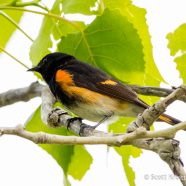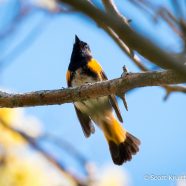American Redstart (Setophaga ruticilla)
The American Redstarts (Setophaga ruticilla) keep on coming! As some of our late-arriving birds like the Blackpoll Warbler are peaking the Redstarts are still pushing through in migration, with others already here building nests. No complaints – we want more of these stunners!
Read MoreAmerican Redstart
Here are a couple more shots from the Noble Proctor BioBlitz Challenge featuring an adult male American Redstart (Setophaga ruticilla). This and many other Redstarts were foraging and singing nonstop on the beautiful spring morning. The species is utterly saturating our region right now with birds that can be seen or heard nearly anywhere you can find trees. I am still seeing mostly males, and I think we have a sizable number of birds yet to come over the next week or two. Scott Kruitbosch Conservation & Outreach Coordinator
Read MoreAmerican Redstart
This is as good of a photo that I could get this morning of the adult male American Redstart (Setophaga ruticilla) seen below, and clearly I need to do better! The conditions were brutal with continued rain and some fog moving in on a very dark day, making the bird stand out even more against the drab surroundings. It was foraging and catching quite a bit while showing those bright wings and that flashy tail to help scare up insects. The weather has been uncooperative for birds as the first few days of the May migratory flight has been difficult with variable winds and precipitation making...
Read MoreLate Eastern Kingbirds
These Eastern Kingbirds (Tyrannus tyrannus) are running a bit behind schedule, and September 30 is now the latest sighting of the species I have had in Connecticut. These photos are of two continuing birds at Stratford Point, the first two shots of the same individual taken against the blue sky on September 28, and the other two being one of each while viewed simultaneously after a cold frontal passage today on September 30. My previous late date was September 19, 2011 at the Boothe Park Hawk Watch. Fortunately for these birds it has been an extremely and historically warm September, but...
Read MoreRuddy-tailed Flycatcher (Terenotriccus erythrurus)
Here’s the Ruddy-tailed Flycatcher (Terenotriccus erythrurus), a very small flycatcher and the only member of its genus. Sean has observed it in a wide variety of habitats in Panama though never in any great number. He noted that on this last trip they were more abundant when he was above 500 meters in elevation. This was also during the beginning of the breeding season for the species, and thus they were very active catching insects. Sean said it was amazing watching them zip out and back from feeding perches, wondering what kind of truly high definition vision these tiny flycatchers...
Read More








